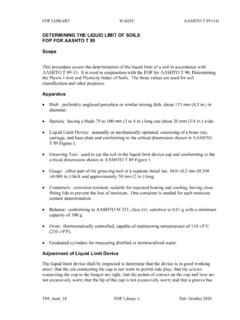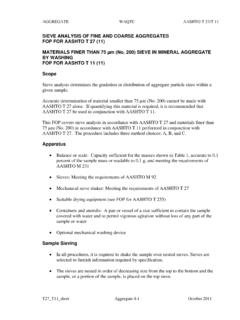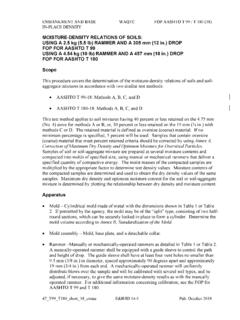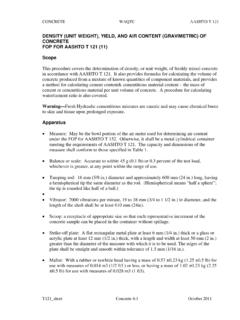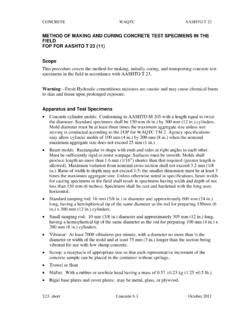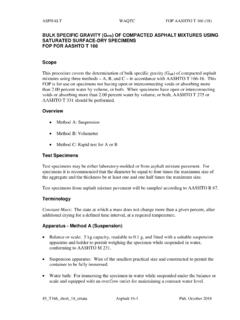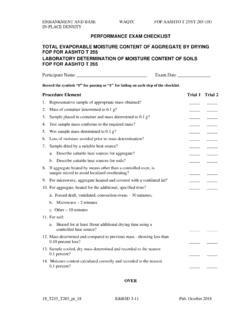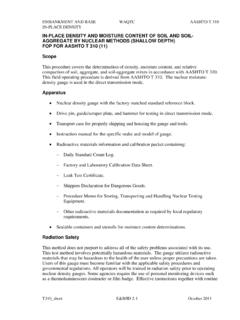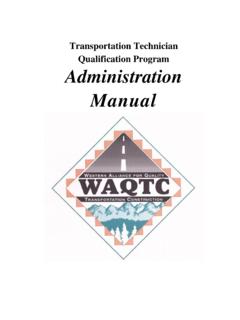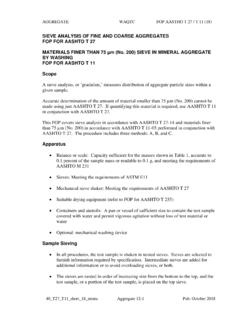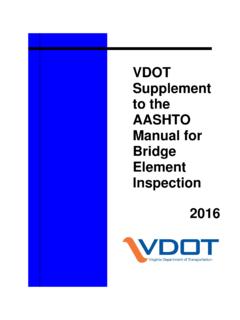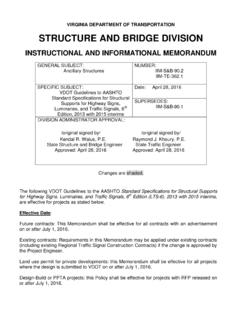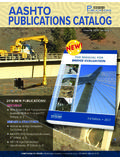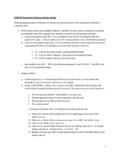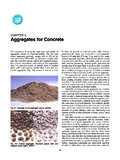Transcription of FOP AASHTO T 2 (16) - WAQTC - The Western …
1 AGGREGATE WAQTC FOP AASHTO T 2 (16) 37_T2_short_16_errata_editorial Aggregate 9-1 Pub. October 2017 SAMPLING OF AGGREGATES FOP FOR AASHTO T 2 Scope This procedure covers sampling of coarse, fine, or a combination of coarse and fine aggregates (CA and FA) in accordance with AASHTO T 2-91. Sampling from conveyor belts, transport units, roadways, and stockpiles is covered. Apparatus Shovels or scoops, or both Sampling tubes of acceptable dimensions Mechanical sampling systems: normally a permanently attached device that allows a sample container to pass perpendicularly through the entire stream of material or diverts the entire stream of material into the container by manual, hydraulic, or pneumatic operation Belt template Sampling containers Procedure General Sampling is as important as testing. The technician shall use every precaution to obtain samples that are representative of the material.
2 D etermine the time or location for sampling in a random manner. 1. Wherever samples are taken, obtain multiple increments of approximately equal size. 2. Mix the increments thoroughly to form a field sample that meets or exceeds the minimum mass recommended in Table 1. AGGREGATE WAQTC FOP AASHTO T 2 (16) 37_T2_short_16_errata_editorial Aggregate 9-2 Pub. October 2017 TABLE 1 Recommended Sample Sizes Nominal Maximum Size* mm (in.) Minimum Mass g (lb) 90 (3 1/2) 175,000 (385) 75 (3) 150,000 (330) 63 (2 1/2) 125,000 (275) 50 (2) 100,000 (220) (1 1/2) 75,000 (165) (1) 50,000 (110) (3/4) 25,000 (55) (1/2) 15,000 (35) (3/8) 10,000 (25) (No. 4) 10,000 (25) (No. 8) 10,000 (25) * One sieve larger than the first sieve to retain more than 10 percent of the material using an agency specified set of sieves based on cumulative percent retained.
3 Where large gaps in specification sieves exist, intermediate sieve(s) may be inserted to determine nominal maximum size. Maximum size is one size larger than nominal maximum size. Note 1: Sample size is based upon the test(s) required. As a general rule, the field sample size should be such that, when split twice will provide a testing sample of proper size. For example, the sample size may be four times that shown in Table 2 of the FOP for AASHTO T 27/T 11, if that mass is more appropriate. Procedure Specific Situations Conveyor Belts Avoid sampling at the beginning or end of the aggregate run due to the potential for segregation. Be careful when sampling in the rain. Make sure to capture fines that may stick to the belt or that the rain tends to wash away. Method A (From the Belt) 1. Stop the belt. 2. Set the sampling template in place on the belt, avoiding intrusion by adjacent material.
4 3. Remove the material from inside the template, including all fines. 4. Obtain at least three approximately equal increments. 5. Combine the increments to form a single sample. AGGREGATE WAQTC FOP AASHTO T 2 (16) 37_T2_short_16_errata_editorial Aggregate 9-3 Pub. October 2017 Method B (From the Belt Discharge) 1. Pass a sampling device through the full stream of the material as it runs off the end of the conveyor belt. The sampling device may be manually, semi-automatic or automatically powered. 2. The sampling device shall pass through the stream at least twice, once in each direction, without overfilling while maintaining a constant speed during the sampling process. 3. When emptying the sampling device into the container, include all fines. 4. Combine the increments to form a single sample. Transport Units 1.
5 Visually divide the unit into four quadrants. 2. Identify one sampling location in each quadrant. 3. Dig down and remove approximately m (1 ft.) of material to avoid surface segregation. Obtain each increment from below this level. 4. Combine the increments to form a single sample. Roadways Method A (Berm or Windrow) 1. Obtain sample before spreading. 2. Take the increments from at least three random locations along the fully-formed windrow or berm. Do not take the increments from the beginning or the end of the windrow or berm. 3. Obtain full cross-section samples of approximately equal size at each location. Take care to exclude the underlying material. 4. Combine the increments to form a single sample. Note 2: Obtaining samples from berms or windrows may yield extra-large samples and may not be the preferred sampling location.
6 AGGREGATE WAQTC FOP AASHTO T 2 (16) 37_T2_short_16_errata_editorial Aggregate 9-4 Pub. October 2017 Method B (In-Place) 1. Obtain sample after spreading and before compaction. 2. Take the increments from at least three random locations. 3. Obtain full-depth increments of approximately equal size from each location. Take care to exclude the underlying material. 4. Combine the increments to form a single sample. Stockpiles Method A Loader sampling 1. Direct the loader operator to enter the stockpile with the bucket at least150 mm (6 in.) above ground level without contaminating the stockpile. 2. Discard the first bucketful. 3. Have the loader re-enter the stockpile and obtain a full loader bucket of the material, tilt the bucket back and up. 4. Form a small sampling pile at the base of the stockpile by gently rolling the material out of the bucket with the bucket just high enough to permit free-flow of the material.
7 (Repeat as necessary.) 5. Create a flat surface by having the loader back drag the small pile. 6. Visually divide the flat surface into four quadrants. 7. Collect an increment from each quadrant by fully inserting the shovel into the flat pile as vertically as possible, take care to exclude the underlying material, roll back the shovel and lift the material slowly out of the pile to avoid material rolling off the shovel. Method B Stockpile Face Sampling 1. Create horizontal surfaces with vertical faces in the top, middle, and bottom third of the stockpile with a shovel or loader. 2. Prevent continued sloughing by shoving a flat board against the vertical face. Sloughed material will be discarded to create the horizontal surface. 3. Obtain sample from the horizontal surface as close to the intersection as possible of the horizontal and vertical faces.
8 AGGREGATE WAQTC FOP AASHTO T 2 (16) 37_T2_short_16_errata_editorial Aggregate 9-5 Pub. October 2017 4. Obtain at least one increment of equal size from each of the top, middle, and bottom thirds of the pile. 5. Combine the increments to form a single sample. Method C Alternate Tube Method ( Fine Aggregate) 1. Remove the outer layer that may have become segregated. 2. Using a sampling tube, obtain one increment of equal size from a minimum of five random locations on the pile. 3. Combine the increments to form a single sample. Note 3: Obtaining samples at stockpiles should be avoided whenever possible due to problems involved in obtaining a representative gradation of material. Report On forms approved by the agency Date Time Sample ID Location Quantity represented AGGREGATE WAQTC FOP AASHTO T 2 (16) 37_T2_short_16_errata_editorial Aggregate 9-6 Pub.
9 October 2017
